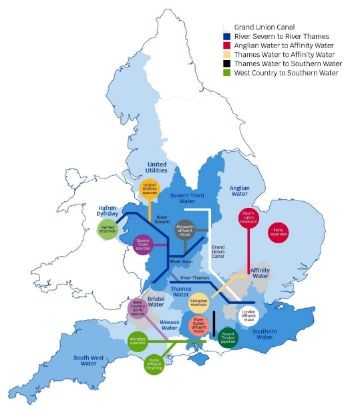Ofwat has published a summary document setting out the key themes which have emerged from the Regulators’ Alliance for Progressing Infrastructure Development (RAPID) assessment of submissions for strategic regional water resource solutions at standard gate one.
The assessment process is overseen by RAPID, with input from the partner regulators – Ofwat, the Environment Agency and the Drinking Water Inspectorate.
The Environment Agency, together with Natural England and, where a solution impacts Wales, Natural Resources Wales, have reviewed the environmental sections of the submissions, while the Consumer Council for Water provided input to the assessment on customer engagement.
The document also identifies areas of focus before gate two which should be acted upon by the solution sponsors. The paper will also enable stakeholders with an interest in more than one solution to understand common themes without needing to read all the decision documents and letters.
Ofwat’s decisions relate to the funding of investigation and development of solutions – including deciding whether companies should be allowed funding to further investigate and develop a solution to gate two.
At PR19 the water regulator allowed a £469 million ring-fenced development fund for companies to investigate and develop strategic water resource solutions that benefit customers, protect and enhance the environment and benefit wider society.
RAPID’s role in the gated process is to assess the progress made in development of each solution and to provide advice and recommendations to enable Ofwat to make decisions on continued ring-fenced funding for solution progression. The purpose of the gated process is to ensure at each gate that:
- companies are progressing strategic water resource solutions that have been allocated funding at PR19;
- costs incurred in doing so are efficient; and
- solutions merit continued investigation and development during the period 2020 to 2025.
Ofwat agrees all solutions should be funded to continue investigations to gate two

Evidence of investigations for 15 solutions was submitted at gate one – Ofwat has now agreed that all solutions should be funded to continue investigations to gate two.
At gate one, the focus was on eliminating solutions that are demonstrated to be unsuitable, no longer require further development funding or will not benefit from the structured gate process.
All the solutions are funded to continue investigations and all the options contained within the solutions will continue, apart from the Roadford pumped storage and transfer options of West Country South sources and West Country Southern transfer. Ofwat and the solution sponsors have agreed to combine these two solutions into one – the Poole effluent recycling and transfers – due to their interdependence on each other.
The United Utilities sources solution and the Vyrnwy Aqueduct solution will also be combined to form the single North West Transfer solution proposed by the solutions’ sponsors.
One new solution, Fens reservoir and Anglian to Cambridge transfer, proposed by Anglian Water and Cambridge Water, has applied to join the programme at gate one. This solution will join the programme and be funded for investigation to gate two.
Maximum projected total cost of proposed solutions is approximately £14.74 billion
For interest and transparency, the paper also includes the costs of the 15 individual solutions, although Ofwat said these are not material to the decisions made at gate one. The maximum projected cost of the proposed solutions is approximately £14.74 billion in total.
Going forward, future submissions must demonstrate that the costs are consistent, reliable, and present them at increasing levels of granularity.
Solution sponsors’ gate two investigations will also be required to provide strong, clear evidence of the justification of the need for a solution. Where possible this should include the wider need from other sectors, e.g. energy and agriculture and emerging technologies such as hydrogen production.
The investigations will also need to explore how other sectors might use water which is available when not needed for public water supply, to increase utilisation and enable third party contributions to the costs.
Expectations for gate two also include the investigation of wider resilience benefits of each solution, including flood risk management, climate change adaptation and supporting the resilience of the natural environment.
Referring to the water sector’s commitment to net zero by 2030, the gate two assessment process will also look for evidence of how carbon reduction policies, frameworks and approaches are driving down wholelife carbon within the solution design. The paper says:
“We would like to see solutions embracing innovative designs and opportunities to generate or be powered by renewable energy and/or sequester carbon and exploring joint opportunities with other sectors. Evidence may be sought as to whether a focus on carbon reduction has been able to drive down solution costs.”
Click here to download RAPID’S Standard gate one key themes and final decisions overview